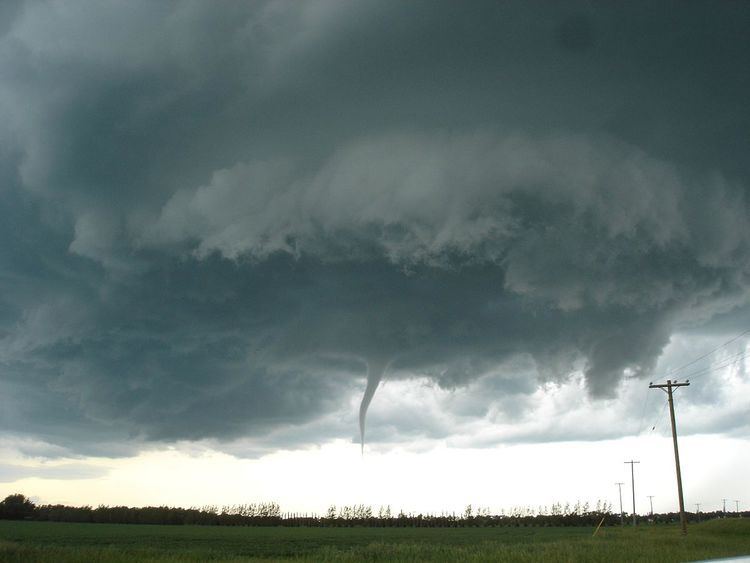 | ||
A funnel cloud is a funnel-shaped cloud of condensed water droplets, associated with a rotating column of wind and extending from the base of a cloud (usually a cumulonimbus or towering cumulus cloud) but not reaching the ground or a water surface. A funnel cloud is usually visible as a cone-shaped or needle like protuberance from the main cloud base. Funnel clouds form most frequently in association with supercell thunderstorms.
If a funnel cloud touches the ground it becomes a tornado. Most tornadoes begin as funnel clouds, but many funnel clouds do not make ground contact and so do not become tornadoes. Also, a tornado does not necessarily need to have an associated condensation funnel—if strong cyclonic winds are occurring at the surface (and connected to a cloud base, regardless of condensation), then the feature is a tornado. Some tornadoes may appear only as a debris swirl, with no obvious funnel cloud extending below the rotating cloud base.
In cloud nomenclature, any funnel- or inverted-funnel-shaped cloud depending from cumulus or cumulonimbus clouds is technically described as an accessory feature called tuba. The terms tuba and funnel cloud are nearly but not exactly synonymous; a wall cloud, for example, is also a form of tuba.
Cold-air funnel clouds
Cold-air funnel clouds (vortices) are usually short-lived and generally much weaker than the vortices produced by supercells. Although cold-air funnels rarely make ground contact, they may touch down briefly and become weak tornadoes or waterspouts.
Unlike the related phenomenon associated with severe thunderstorms, cold-air funnels are generally associated with partly cloudy skies in the wake of cold fronts, where atmospheric instability and moisture is sufficient to support towering cumulus clouds but not precipitation. The mixing of cooler air in the lower troposphere with air flowing in a different direction in the middle troposphere causes the rotation on a horizontal axis, which, when deflected vertically by atmospheric conditions, can become a funnel cloud.
They are a common sight along the Pacific Coast of the United States, particularly in the spring or fall.
On July 29, 2013, a cold-core funnel cloud touched down as an EF0 tornado in Ottawa, Canada, causing extensive damage in the form of downed trees on a golf course. No advance weather watches or warnings were issued by Environment Canada, and the tornado was spawned from one of the few non-severe storm clouds moving through the area.
